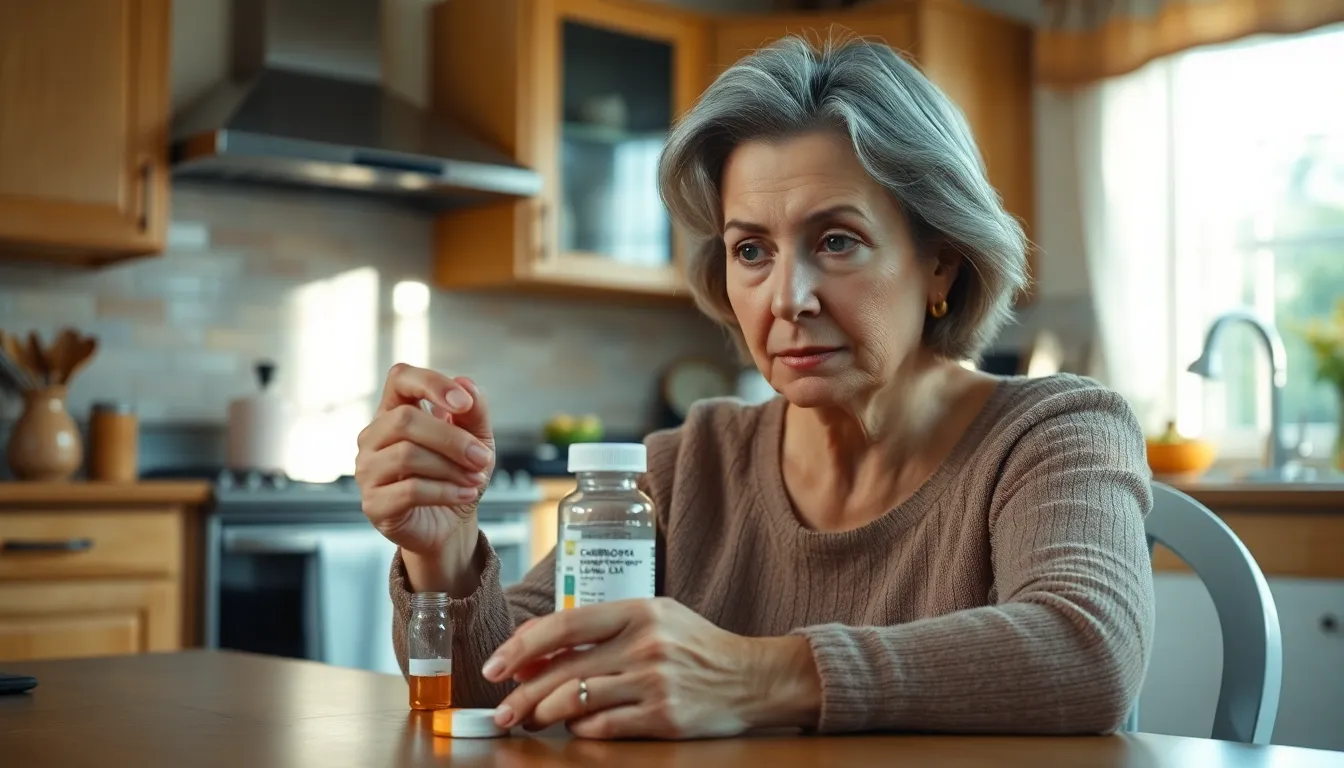Carbidopa levodopa 25/100 is a cornerstone treatment for managing Parkinson’s disease symptoms. This combination medication works by replenishing dopamine levels in the brain, helping to alleviate motor symptoms like tremors and stiffness. Understanding the correct dosage is crucial for maximizing its effectiveness while minimizing side effects.
For those starting on carbidopa levodopa, determining the right dosage can feel overwhelming. The 25/100 formulation refers to 25 mg of carbidopa and 100 mg of levodopa, typically prescribed to balance efficacy and tolerability. As patients navigate their treatment journey, knowing how to adjust dosages and what to expect can empower them to take control of their health.
Table of Contents
ToggleOverview of Carbidopa Levodopa 25/100 Dosage
Carbidopa levodopa 25/100 consists of 25 mg of carbidopa and 100 mg of levodopa. This combination medication primarily treats the motor symptoms of Parkinson’s disease by enhancing dopamine activity in the brain. Proper dosage is critical for achieving the best therapeutic outcomes while limiting side effects.
Dosage adjustments are common based on individual patient response and tolerance. Generally, doctors initiate treatment with lower doses, gradually increasing them to optimize symptom control. The typical starting dose often ranges from one to two tablets per day, taken in divided doses.
Patients may experience varying responses to the medication. Some may require higher doses to manage symptoms effectively, while others might attain adequate relief with lower doses. Frequent consultations with healthcare providers ensure personalized treatment plans.
It’s crucial for patients to follow their prescribed dosage strictly. Skipping doses or abruptly stopping medication can lead to withdrawal symptoms or significant worsening of Parkinson’s symptoms. Consistent adherence to the medication regimen contributes to improved quality of life.
Regular monitoring allows healthcare professionals to make necessary adjustments based on patient feedback and observed side effects. Side effects can include nausea, dizziness, and dyskinesia, occurring more frequently at higher dosages.
Patients should discuss any unusual symptoms or concerns with their healthcare provider. Understanding the nuances of carbidopa levodopa 25/100 dosage empowers patients to actively participate in their treatment journey.
Mechanism of Action

Carbidopa levodopa 25/100 works primarily to restore dopamine levels in the brain, alleviating motor symptoms associated with Parkinson’s disease. This combination enhances the efficacy of treatment and minimizes side effects.
Role of Levodopa
Levodopa serves as a precursor to dopamine, enabling the brain to produce this critical neurotransmitter. Once administered, levodopa converts to dopamine in the brain, addressing symptoms like tremors and stiffness. The dosage of 100 mg facilitates sufficient dopamine synthesis to manage Parkinsonian symptoms effectively. However, increased dosages may lead to side effects such as dyskinesia, reflecting the importance of tailored dosing strategies.
Role of Carbidopa
Carbidopa acts as an inhibitor of dopa decarboxylase. This mechanism prevents the premature conversion of levodopa to dopamine outside the brain, minimizing gastrointestinal side effects such as nausea and vomiting. The 25 mg dose of carbidopa ensures that more levodopa reaches the brain where it is needed most, thereby enhancing the therapeutic effects while reducing systemic side effects. This combination optimizes the therapeutic response and supports better adherence to the medication regimen.
Indications and Uses
Carbidopa levodopa 25/100 serves as a crucial medication for managing symptoms of Parkinson’s disease. This combination medication effectively improves motor functions by increasing dopamine levels in the brain.
Treatment of Parkinson’s Disease
Carbidopa levodopa 25/100 specifically targets the motor symptoms associated with Parkinson’s disease, including tremors, rigidity, and bradykinesia. The dosage of 100 mg of levodopa supports adequate dopamine synthesis, while the 25 mg of carbidopa enhances absorption and minimizes gastrointestinal side effects. Patients often experience improved mobility and overall quality of life when adhering to prescribed dosages. Regular adjustments may occur based on individual responses, making it essential for healthcare providers to monitor each patient’s progress closely.
Other Potential Uses
Carbidopa levodopa has potential uses beyond Parkinson’s disease. It may be considered for treating conditions that involve dopamine deficiency, such as certain movement disorders. While these uses are less common, emerging research suggests effectiveness in specific cases. As with any medication, healthcare providers assess benefits versus risks before prescribing it for off-label use. Regular evaluations ensure optimal outcomes, emphasizing the importance of appropriate clinical guidance when considering alternative applications.
Dosage Guidelines
Dosage guidelines for carbidopa levodopa 25/100 are crucial for effective symptom management in Parkinson’s disease. Understanding the recommended dosage and adjustment factors ensures optimal therapeutic outcomes.
Recommended Dosage
The typical starting dosage of carbidopa levodopa 25/100 is one tablet taken three times per day. Depending on the patient’s response and tolerability, physicians may increase the dosage gradually, with a common maximum of eight tablets daily. Regular assessments guide adjustments. Patients must adhere strictly to prescribed schedules; irregular intake increases the risk of symptom fluctuations and adverse effects. Healthcare providers generally recommend administering the medication 30 minutes to one hour before meals to enhance absorption and effectiveness.
Adjustment Factors
Adjustment factors for carbidopa levodopa dosage depend on individual response, tolerance, and side effects experienced. The following factors influence dosage modifications:
- Age: Older adults may require lower doses due to increased sensitivity.
- Weight: Heavier patients might need higher starting doses for effective symptom control.
- Severity of Symptoms: Patients with more severe symptoms often require higher dosages for optimal relief.
- Side Effects: If side effects such as dyskinesia or nausea occur, healthcare providers may reduce dosages or adjust the timing of doses.
- Concurrent Medications: Other medications can affect levodopa’s effectiveness; adjustments may be necessary based on interactions.
Regular communication with healthcare professionals supports optimal dosage adjustments and enhances treatment efficacy.
Side Effects and Precautions
Carbidopa levodopa 25/100 can lead to several side effects. Awareness of these effects helps manage expectations and treatment plans.
Common Side Effects
Common side effects include:
- Nausea: Patients may experience mild stomach upset, especially during the initial treatment phase.
- Dizziness: Issues with balance can occur, particularly when standing up quickly.
- Dyskinesia: Involuntary movements often arise with increasing doses, impacting daily activities.
- Fatigue: A general feeling of tiredness may manifest as the body adjusts to the medication.
- Dry Mouth: This condition can affect comfort and hydration, impacting overall well-being.
Patients should monitor these common effects and report persistent occurrences to their healthcare providers.
Serious Side Effects
Serious side effects, though less common, require immediate medical attention. These include:
- Severe Allergic Reactions: Symptoms like rash, itching, or swelling can indicate an allergy.
- Psychiatric Symptoms: These may include hallucinations, confusion, or severe mood changes.
- Orthostatic Hypotension: Significant drops in blood pressure upon standing can lead to fainting.
- New or Worsening Dyskinesia: An increase in involuntary movements may signal the need for dosage reassessment.
- Heart Issues: Irregular heartbeat or chest pain warrants urgent evaluation.
Patients experiencing serious side effects should contact their healthcare providers immediately for advice and possible intervention.
Carbidopa levodopa 25/100 plays a crucial role in managing Parkinson’s disease symptoms. Understanding the proper dosage is vital for maximizing benefits while minimizing side effects. Each patient’s response can vary significantly, making regular communication with healthcare providers essential for effective treatment adjustments.
Patients should remain vigilant about potential side effects and actively participate in their treatment journey. By adhering to prescribed dosages and monitoring their health closely, individuals can enhance their quality of life and better manage the challenges posed by Parkinson’s disease.







